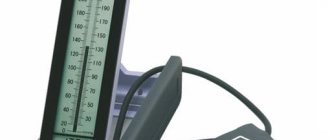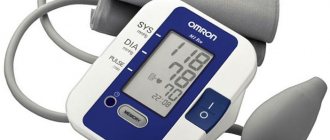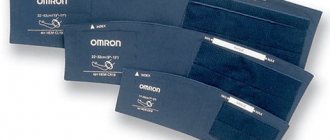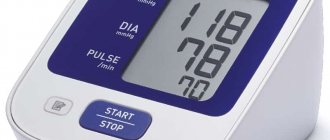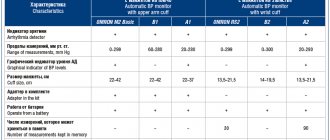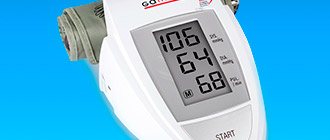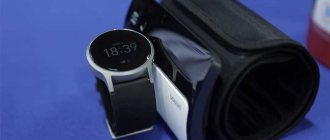A tonometer is a necessary thing in the house, and one can hardly argue with that. Many people mistakenly believe that this device is necessary only for older people, but this is not true, because attacks of poor health against the background of high or, conversely, low blood pressure also occur in young people. And in general, knowing your indicators will not be superfluous for those who consider themselves to be a completely healthy person.
According to statistics, cardiovascular diseases occupy a leading position among the causes of death in patients of all ages. As you know, forewarned is forearmed, so doctors strongly recommend monitoring your blood pressure and pulse. The best assistant in this matter is a tonometer. Many homes still have outdated mechanical models, which, to be fair, give fairly accurate readings, but are not very convenient to use and require some skill.
The market offers a wide range of modern automatic devices with a whole range of additional functions. FAN journalist decided to figure out how to choose the most accurate and reliable tonometer for home use.
pixabay.com/tomwieden
Mechanical blood pressure monitors
The mechanical tonometer kit includes an analog pressure gauge with a pointer, an elastic cuff and a pressure pump connected by tubes.
A stethoscope is also included, which in some models is built into the cuff. Blood pressure is measured using a mechanical tonometer using the classical Korotkoff method. It is based on listening to the characteristic noises in the arteries that occur in the vessels after they are compressed. These sounds are called “Korotkoff sounds.”
Korotkoff sounds are listened to using a stethoscope.
When measuring blood pressure, a cuff is placed on the upper arm, the forearm is placed on a flat surface, and the head of the stethoscope is placed in the cubital fossa above the artery. The pump manually inflates the pressure in the cuff. When it becomes higher than arterial, blood flow in the compressed vessels will stop, and there will be silence in the stethoscope.
The air is then slowly released from the cuff. When the pressure in the cuff equals the systolic pressure, the first Korotkoff sound is heard. The pressure gauge reading at this moment is the systolic pressure. As the cuff deflates, the sounds change, successively changing five phases. The doctor is able to judge the patient’s health by these tones. The sounds disappear when the cuff pressure reaches diastolic blood pressure.
Arterial refers to the pressure that blood exerts on the walls of the arteries. At the moment of contraction of the ventricles of the heart, systolic blood pressure is noted, and at the moment of relaxation of the heart muscle, diastolic blood pressure is noted.
Advantages:
- provide high measurement accuracy;
- inexpensive,
- No power required for operation.
Flaws:
- require certain skills, especially when measuring blood pressure yourself;
- the person measuring needs good hearing and silence;
- it is necessary to manually inflate the pressure in the cuff. This may not be easy if the person is elderly or frail;
- When measuring your blood pressure, work with a bulb to slightly increase your blood pressure.
By the way, the reference devices are still mercury tonometers, which are almost never used in ordinary practice today. Although you can also find and buy them. But it’s hardly necessary - they are bulky and inconvenient.
Rating of popular brands
AuthorVoting
- 1 Little Doctor - Little Doctor has been on the market for over 30 years. The company is engaged in the production of medical equipment, medical products and medical clothing. The product catalog includes tonometers, thermometers, stethoscopes and other diagnostic equipment.
- 2 AND (A&D) - this popular Japanese company was founded in 1977. The range of products produced is also wide: similar to Little Doctor, the company produces medical equipment and develops the principles of new technologies. The main direction in development is high-precision devices for measuring blood pressure. In addition, the company's product range also includes pedometers.
- 3 B.Well is another well-known young brand, founded in 2004 and has already become one of the leaders in the production of not only medical equipment, but also orthopedic products (insoles, bandages, compression stockings, crutches). The company produces products for the whole family - its range also includes children's products, such as aspirators, humidifiers, scales, inhalers, and thermometers.
- 4 Omron - the company was founded in 1933 and is one of the oldest companies on the market - its history goes back almost 100 years. In addition to medical equipment, the company is engaged in the production of electronic components, which are present in almost any automatic or digital product that people use in everyday life, and industrial automation.
Also trustworthy: Nissei, Tensoval, Johnson&Johnson, Armed.
Long-term presence on the market already significantly increases trust in brands. But you can’t focus on this factor alone - one brand can have both models of the highest quality and quite mediocre ones.
Semi-automatic and automatic blood pressure monitors
Automatic and semi-automatic blood pressure monitors also measure blood pressure using a compression cuff. In the case of semi-automatic machines, the cuff is inflated manually, and the release is automatic. The machines are equipped with a compressor that operates at the touch of a button.
The operation of most of these pressure gauges is based on the oscillometric method of measuring blood pressure. The device takes readings based on changes in pressure in the cuff that occur under the influence of blood flow at the time of compression. Oscillometry also allows you to record pulse data and whether there is atrial fibrillation. The results of all measurements are displayed on an electronic monitor.
The latest generation automatic blood pressure monitors are high-tech devices. They can be synchronized with a smartphone to upload measurement data to special applications.
Advantages:
- easy to use, including for measuring your own blood pressure at home;
- even the deaf can use them; There are models for people with low vision;
- provide a larger volume of information compared to mechanical tonometers;
- models with memory allow you to store information about the latest measurements.
Flaws:
- more expensive than mechanical devices, especially automatic machines. The price of a modern automatic model can be several thousand rubles.
- require mains power and/or batteries;
- may be inferior in accuracy to mechanical devices.
Reviews of different models of devices
Until now there was no need for this device. During pregnancy, it turned out that I had low blood pressure and the doctor advised me to monitor it, that is, constantly measure it. My mother had an Omron blood pressure monitor, only a different model. He has proven himself well. Therefore, my choice fell on the Omron M2 classic tonometer. Easy to use. It is possible to use batteries and mains power. No need to think about where to measure pressure. He has been helping me out for over a year now and I have no complaints about the work. There may be a discrepancy in the readings if measured manually, but I still choose automatic measurement - simple and fast. I advise you to buy. Such a thing should be in every home, especially if there are problems with blood pressure.
taianagoi
https://irecommend.ru/users/taianagoi
Tonometer AND Medical UA-777. I was looking for exactly this one, since I don’t know how to measure blood pressure with a mechanical tonometer. Now all tonometers of this company are manufactured in China. On the box of the AND Medical tonometer there is a convenient table with WHO (World Health Organization) data on normal, high and hypertensive pressure. The cuff is wide (32–45 cm), suitable for full hands. On the cuff itself there are instructions for proper fastening. The device has an AC adapter, that is, it works from a power outlet. And if you want to take it with you on the road, it can run on batteries that are included (4 pieces). Measuring pressure with this device is as easy as shelling pears. Connect it to the adapter, or install batteries. Put on the cuff as indicated in the instructions, 1–2 cm above the elbow, not too tight so that 2–3 fingers can be placed under it, but not too loose. The air injection tube should be located above the elbow fossa. Only after all installations press start, the device will begin to pump air into the cuff. The device shows the upper and lower pressure, plus the pulse. Another additional function of AND Medical is the “arrhythmia indicator”. If during measurements the device detects an arrhythmia, a heart will appear on the screen (in the photo below it is in a red circle), not to be confused with the heart to the left of the pulse value. The AND Medical tonometer also has a memory function for 90 measurements, and saves the values automatically. How to measure pressure correctly with the AND Medical tonometer? For some reason, some doctors put the cuff not above the elbow joint, but directly on it, as far as I know this is not entirely correct, you need to put the cuff 2 cm above the elbow joint. When measuring, it is advisable to sit and relax. It is best to measure the pressure on the left arm. Do not measure the pressure immediately after eating and drinking plenty of fluids. Measurements on different hands (right, left) may differ slightly. Many complain that the device shows different pressure on both hands, or even on the same hand. It is important to take into account the fact that this tonometer is not intended for simultaneously measuring pressure multiple times. After you have measured your blood pressure, wait 10 minutes and if in doubt, measure again. Do you need a tonometer every day? If you do not have high blood pressure, then there is no urgent need for a tonometer. But I would still recommend having it at home and monitoring your health. For example, if in good condition your blood pressure is 90 over 60, then with a pressure of 120 over 90, you will feel bad, I think everyone needs to know their “working” ideal pressure. I also use a tonometer after physical activity to know my blood pressure and, most importantly, my pulse after training. Thank you for your attention, I hope it was useful))
Suavitatis
https://irecommend.ru/content/tonometr-and-medical-instruktsiya-po-primeneniyu-kak-izmeryat-davlenie-pravilno-nuzhen-li-to
I bought a Nissei WS-820 blood pressure monitor exclusively for myself. It was recommended in an online store, I looked at reviews on websites and, in general, I carefully approached the purchase - health, after all. I measured several (specifically on the wrist), I really liked the idea of such a compact device. And here it turned out that not everything was so simple: in people my age, and I’m 42, the pulse on the wrist is no longer measured so clearly, the blood vessels are not so elastic. Expected, of course, but I didn’t think it was particularly important. Then I started looking, not particularly relying on advertising, and first bought Microlife. When you measure, the values differ. Not much, of course, but within 10 units. Of course, you can understand whether you have high blood pressure or not, but it’s still not certain. I went to the store and they said it’s normal and it stays like that throughout the day. I have doubts, I think, maybe I shouldn’t flirt and just buy a machine gun for my shoulder? But I decided to give it a try anyway. And I settled on this brand. I tried it - heaven and earth, everything measures clearly, the spread is no more than 3-5 units for three measurements! I am 100% satisfied with the device! A small drawback is that the buttons move a little stiffly. But these are just nitpicking :). Conclusion: read the instructions and be healthy!
Fortuner
https://irecommend.ru/content/khoroshii-tonometr-1
Why are mechanical blood pressure monitors more accurate?
Measuring pressure using the Korotkoff method remains the most accurate.
So, a mechanical tonometer is a good option for use by professionals. And more and more people are choosing automatic machines for home use. But there is a pitfall here.
Judging the accuracy of a tonometer is not easy. In the instructions, the permissible level of which is 5 mm Hg. Art. But this is an error in measuring pressure in the cuff, and not in the human artery.
There is also a “methodological measurement error”, which is avoided in the company’s technical documentation. This indicator indicates the accuracy of blood pressure measurement by each method. This is where automatic and semi-automatic machines are inferior to mechanics.
An oscillometric device has a complex algorithm, and accuracy depends on many factors. For example, machines may have different measurement errors for a young and an elderly person, a patient with and without cardiovascular disease.
Of course, every reputable manufacturing company tests each batch of tonometers. But it may turn out that a particular device is not suitable for you.
What to do: not buy semi- or fully automatic blood pressure monitors at all? Actually, not necessarily.
What modern technologies do automatic pressure meters use?
Measuring technologies in automatic blood pressure monitors have been actively developing recently. Improvements are aimed at reducing measurement time, creating gentle conditions for the user, and increasing measurement accuracy. Here are examples of the most useful technical solutions:
- MAM technology significantly improves the accuracy of pressure measurements. The device automatically takes 3 measurements in 2 minutes, analyzes and calculates their average value.
- PAD technology is capable of identifying arrhythmia and assessing the degree of its impact on measurement accuracy. The appearance of an arrhythmia indicator on the display should alert the user.
- Intellisense technology controls the operation of the compressor, forcing it to maintain such an optimal pressure in the system, which helps reduce measurement time, reduces pain from an inflated cuff, and prevents errors in the event of short-term arrhythmia.
- Fuzzy Logic technology can automatically adjust the required amount of air pressure in the cuff.
- IQ System technology - uses intelligent logic and increased sensitivity to pulse reading. This approach allows:
- significantly reduce pressure measurement time;
- reduce the time of compression of the arteries of the arm with an inflated membrane;
- double the service life of aniline batteries.
How to choose an electronic tonometer
- Choose devices from well-known manufacturers. These are, for example, the Omron brand, AND (colloquially “Andes”) and a number of others.
- Before you buy a blood pressure monitor, make sure it is genuine. The supplier must be an official distributor of the manufacturer!
- At the pharmacy, ask to measure your blood pressure using several devices, including mechanical ones. Choose the machine whose result more accurately corresponds to measurements using the Korotkov method.
When purchasing a tonometer, do not hesitate to ask the most meticulous questions.
When choosing an automatic tonometer, you should also consider the features of different models:
- Tonometers with fixation on the shoulder. The size of the cuff should correspond to the volume of the arm. There are models with a universal cuff size, but their readings are considered less accurate. Shoulder blood pressure monitors may not be suitable for people who are overweight or very thin. It should also be taken into account that the cuff of the electronic blood pressure monitor is suitable only for the right or only the left hand.
- With fixation on the wrist. In appearance, it resembles a watch, since the monitor is attached directly to the cuff. A wrist blood pressure monitor may not be suitable for people over 40 years of age. From this age, blood vessels become harder, which reduces the reliability of blood pressure measurements.
- With fixation on the finger. Convenient miniature size and portability. But they are not yet widely used because they are not highly accurate.
And one more thing: after purchasing a tonometer, use it strictly according to the instructions. Only in this case the measurement results will be correct.
How to measure blood pressure correctly
In addition to the quality of the tonometer itself, some other factors also influence the accuracy of the measurements. To get the most accurate results, try to follow these rules:
- Measure your blood pressure at rest, not after exercise or stress. Immediately before the manipulation, sit quietly for a few minutes and try to completely relax.
- The mobile phone should be put away.
- Carry out the manipulation in a sitting position, maximum - lying down if the person cannot sit due to poor health.
- Avoid drinking caffeinated drinks at least one hour before your procedure.
- Empty your bladder first.
- Take the most comfortable and relaxed position; the cuff should not squeeze your arm or, conversely, dangle freely. At the same time, it is advisable not to slouch and not talk.
- About 1.5 hours should pass after eating.
- Do not smoke! It would be better at all, but at least an hour before the procedure - for sure.
- The measurement area should be at heart level. When using a shoulder tonometer, the left hand rests on the table in a calm state, the wrist one is bent at the elbow and supported by the right hand.
- Feet should be flat on the floor. Don't cross them or sit cross-legged.
pixabay.com/cdz
What is AFIB technology
One of the main advantages of semi-automatic and automatic blood pressure monitors is the use of AIFB technology to recognize atrial fibrillation.
Atrial fibrillation is a disruption of the normal functioning of the heart and atria, resulting in an increased risk of blood clots, stroke or heart attack. In 70% of cases, the pathology develops almost asymptomatically and is diagnosed only during routine examinations. A pathological condition that goes unnoticed increases the risk of stroke by 5 times and is its cause in 20% of cases.
AIFB technology, used in modern electronic blood pressure monitors, allows for early diagnosis and identification of cardiac disorders at the development stage. To do this, the device takes measurements three times, displaying the average value on the display screen. The measurement accuracy in this case is close to 100%.
The best manufacturers of tonometers - which company to choose
Before purchasing a tonometer, pay attention to the manufacturer. You should not purchase devices from companies with a dubious reputation, otherwise you risk buying a low-quality product.
We have prepared a list of companies that are recommended by leading experts in the world:
1.Omron
2.Microlife
3. Nissei
4. Beurer
Devices of these brands have been certified according to international protocols. Thanks to the experience of highly qualified specialists and the use of the latest technologies, the products received the highest rating in terms of accuracy.
You can find out which models of devices are considered the highest quality from our rating of the best tonometers.
Recommendations: 14 Best Glucose Meters
9 best crutches
9 best blood pressure monitors
